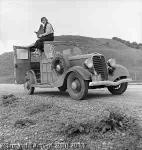Dorothea Lange
Dorothea Lange
Place: Hoboken
Born: 1895
Death: 1965
Biography:
Dorothea Lange was an American documentary photographer and photojournalist, best known for her Depression-era work for the Farm Security Administration (FSA). Lange's photographs humanized the consequences of the Great Depression and influenced the development of documentary photography.
Dorothea Margaretta Nutzhorn was born on May 26, 1895, at 1041 Bloomfield Street, Hoboken, New Jersey to second-generation German immigrants Heinrich Nutzhorn and Johanna Lange. She had a younger brother, Martin. She dropped her middle name and assumed her mother's maiden name after her father abandoned the family when she was 12 years old, one of two traumatic incidents early in her life. The other was her contraction of polio at age seven, which left her with a weakened right leg and a permanent limp. "It formed me, guided me, instructed me, helped me and humiliated me," Lange once said of her altered gait. "I've never gotten over it, and I am aware of the force and power of it."
Lange graduated from the Wadleigh High School for Girls and although she had never operated or owned a camera, she was adamant that she would become a photographer upon graduating high school. Lange was educated in photography at Columbia University in New York City, in a class taught by Clarence H. White. She was informally apprenticed to several New York photography studios, including that of the famed Arnold Genthe. In 1918, she left New York with a female friend to travel the world, but was forced to end the trip in San Francisco due to a robbery and settled there, working as a photo finisher at a photographic supply shop. While working at this shop, Lange became acquainted with other photographers and met an investor that aided in the establishment of a successful portrait studio. This business supported Lange and her family for the next 15 years. In 1920, she married the noted western painter Maynard Dixon, with whom she had two sons, Daniel, born in 1925, and John, born in 1930.
Lange's early studio work mostly involved shooting portrait photographs of the social elite in San Francisco. However, with the onset of the Great Depression, Lange turned her camera lens from the studio to the street. Her photos during this period were reflected in much of John Steinbeck’s writing in The Grapes of Wrath. Her studies of unemployed and homeless people, starting with White Angel Breadline (1933) which depicted a lone man facing away from the crowd in front of a soup kitchen run by a widow known as the White Angel, captured the attention of local photographers and led to her employment with the federal Resettlement Administration (RA), later called the Farm Security Administration (FSA).
In December 1935, she and Dixon divorced and she married economist Paul Schuster Taylor, Professor of Economics at the University of California, Berkeley. For the next five years they documented rural poverty and the exploitation of sharecroppers and migrant laborers – Taylor interviewing and gathering economic data, Lange taking photos. She lived in Berkeley for the rest of her life.
Working for the Resettlement Administration and Farm Security Administration, they brought the plight of the poor and forgotten – particularly sharecroppers, displaced farm families, and migrant workers – to public attention. Distributed free to newspapers across the country, her poignant images became icons of the era.
One of Lange's most recognized works is titled Migrant Mother. The woman in the photo is Florence Owens Thompson. In 1960, Lange spoke about her experience taking the photograph:
I saw and approached the hungry and desperate mother, as if drawn by a magnet. I do not remember how I explained my presence or my camera to her, but I do remember she asked me no questions. I made five exposures, working closer and closer from the same direction. I did not ask her name or her history. She told me her age, that she was thirty-two. She said that they had been living on frozen vegetables from the surrounding fields, and birds that the children killed. She had just sold the tires from her car to buy food. There she sat in that lean-to tent with her children huddled around her, and seemed to know that my pictures might help her, and so she helped me. There was a sort of equality about it.
After Lange returned home, she told the editor of a San Francisco newspaper about conditions at the camp and provided him with two of her photos. The editor informed federal authorities and published an article that included the photos. As a result, the government rushed aid to the camp to prevent starvation.
According to Thompson's son, Lange got some details of this story wrong, but the impact of the picture was based on the image showing the strength and need of migrant workers. Twenty-two of the photographs she took as part of the FSA were included in John Steinbeck's The Harvest Gypsies when it was originally published in The San Francisco News in 1936.
More...
Wikipedia link: Click Here














